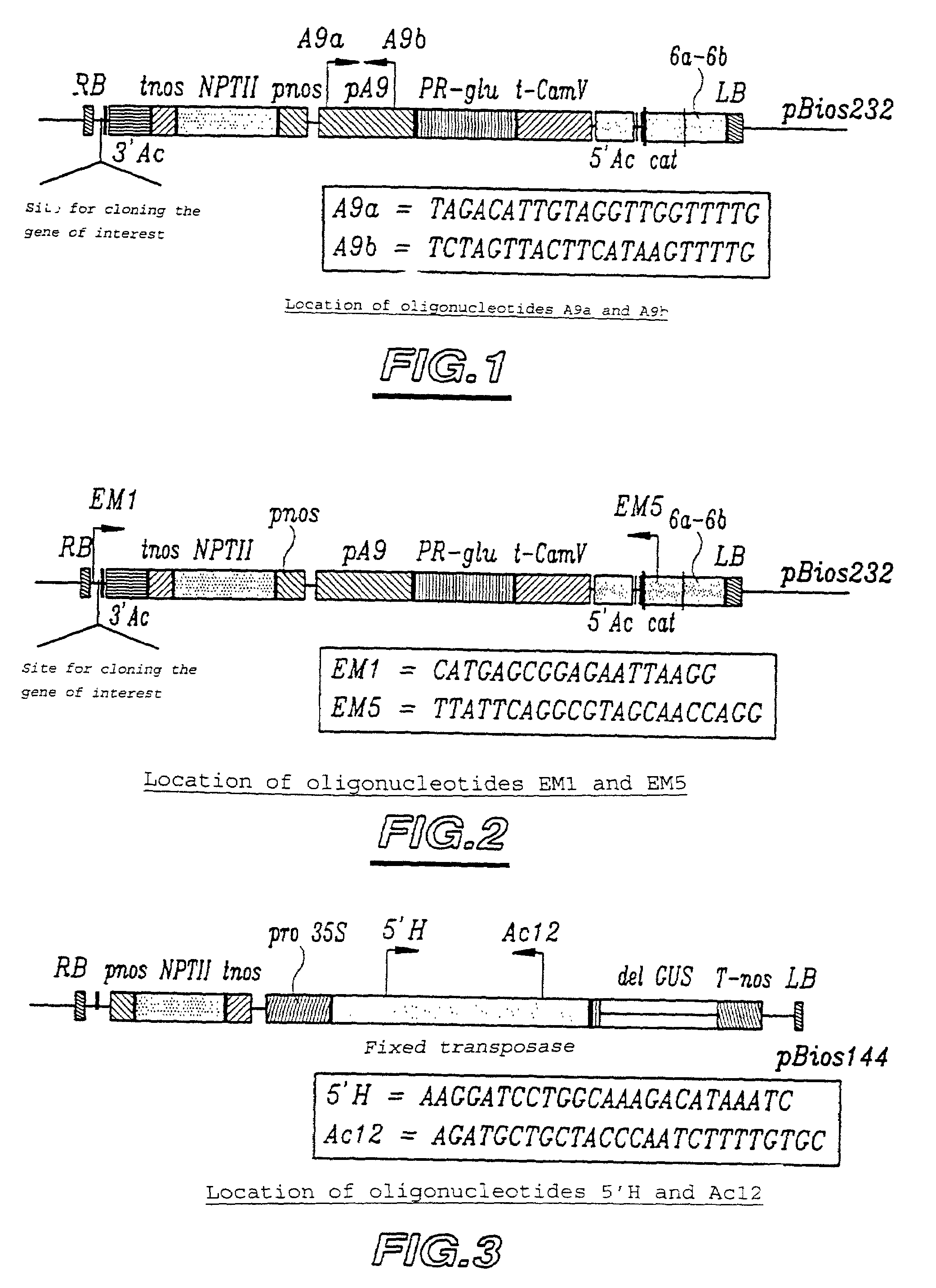Use of male sterility to prevent transgene spread in plants
a technology of sterility and plants, applied in the field of use of male sterility, can solve the problems of limiting and becoming problematic, no technical development in this sense implemented, and it is impossible to anticipate the successful implementation of such a development on account, so as to prevent the spread of transgenes, and avoid the effect of transgenes
- Summary
- Abstract
- Description
- Claims
- Application Information
AI Technical Summary
Benefits of technology
Problems solved by technology
Method used
Image
Examples
example 1
[0101]Construction of a Binary Plasmid which Combines Male Sterility which is Conferred by the Gene Encoding PR Glucanase, Production of Gog Gastric Lipase, Selection on Kanamycin and Selection on Basta, and which can be used in Rape Transgenesis.
[0102]The “binary” plasmid derivative of pGA492 (An, 1986), which contains the following sequences on its transfer DNA between the right and left borders originating from the Agrobacterium tumefaciens pTiT37 plasmid: the constitutive promoter of the nos gene encoding nopaline synthase (Depicker et al., 1982), the sequence encoding the NPTII gene, which encodes neomycin phosphotransferase which confers resistance to kanamycin (Berg and Berg, 1983), which sequence has been deleted for the region of the first 8 codons, including the methionine ATG start codon, and fused to the sequence of the first 14 codons of the sequence encoding the nos gene (Depicker et al., 1982), the sequence which encodes the nos gene but which lacks the region of the ...
example 2
[0112]Construction of a Binary Plasmid which Combines Male Sterility Conferred by the Gene Encoding Barnase, Production of Dog Gastric Lipase, Selection on Kanamycin and Selection on Basta, and which can be Used in Rape Transgenesis.
[0113]a) Construction of the Plasmid pBIOC504 Carrying the Gene Conferring Male Sterility.
[0114]The chimeric gene which corresponds to the “A9-barnase-T35S promoter”, which is contained in pWP173 (Paul et al., 1992), was used. The KpnI / EcoRV fragment carrying this chimeric gene was inserted at the KpnI and SmaI sites of the pBluescript KS+ plasmid which is marketed by Stratagene. The KpnI / SstI fragment carrying the above-described chimeric gene was obtained from the resulting plasmid and introduced at the KpnI and SstI sites of pGA492. The resulting vector is termed pBIOC504. The plasmid DNA harboured by the resulting clones, which were selected on medium containing 50 μg of ampicillin / ml, was extracted by the method of alkaline lysis and analysed by enz...
example 3
[0122]Obtaining Trangenic Rape Plants
[0123]Spring rape (Brassica napus cv WESTAR or Limagrain lines) seeds are disinfected for 40 minutes in a 15% Domestos solution. After four rinses with sterile water, the seeds are set, at the rate of 20 seeds per pot of 7 cm in diameter and 10 cm in height, to germinate on Murashige and Skoog mineral medium (Sigma M 5519) which contains 30 g of sucrose / l and which is solidified with 5 g of agar gel / l. These pots are placed in a 26° C. culture chamber with a photoperiod of 16H / 8H and under a luminous intensity of the order of 80 μE.m−2.S−1.
[0124]After five days of germination, the cotyledons are collected in a sterile manner by cutting each petiole approximately 1 mm above the cotyledon node.
[0125]In parallel, Agrobacterium tumefaciens strain LBA4404, which harbours the binary plasmids, is precultured at 28° C. for 36 hours in 10 ml of 2YT bacterial medium (Sambrook et al., 1989), which is supplemented with the antibiotics which can be used for s...
PUM
| Property | Measurement | Unit |
|---|---|---|
| Sterile | aaaaa | aaaaa |
Abstract
Description
Claims
Application Information
 Login to View More
Login to View More - R&D
- Intellectual Property
- Life Sciences
- Materials
- Tech Scout
- Unparalleled Data Quality
- Higher Quality Content
- 60% Fewer Hallucinations
Browse by: Latest US Patents, China's latest patents, Technical Efficacy Thesaurus, Application Domain, Technology Topic, Popular Technical Reports.
© 2025 PatSnap. All rights reserved.Legal|Privacy policy|Modern Slavery Act Transparency Statement|Sitemap|About US| Contact US: help@patsnap.com

